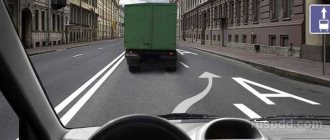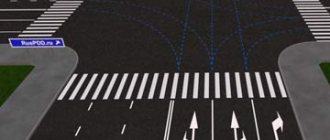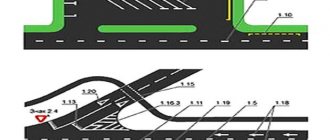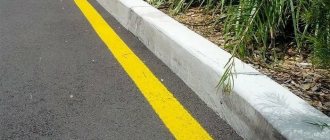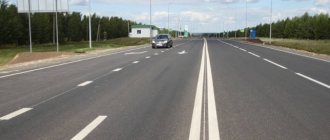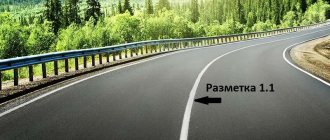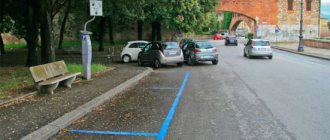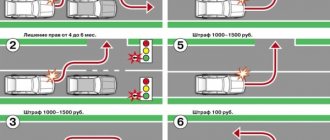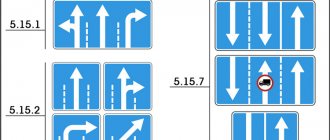Three main colors of road markings: choose the most important one
If you drive a car or often drive it as a passenger, then, of course, you see markings on the roads.
The first category of markings must be monitored in accordance with traffic rules, the second one one way or another becomes an involuntary witness to “standardized creativity” on the roads. see also
We remind you: A new type of marking will be introduced from June 1, 2021
Moreover, as you can see, road markings differ not only in appearance (solid, intermittent, pedestrian crossing, various speed limit signs, “Caution: children!” and so on), but also by color.
And if previously the palette of paints was given to road workers in a rather meager set, then with the coming into force of GOST R 51256-2018 in 2021, the paints sparkled with new colors:
White Yellow Red For temporary road markings, the color is set to orange and even blue green black
Moreover, all six colors, except those designated as temporary orange, are included in the technical requirements for permanent horizontal markings. That is, according to GOST, road workers can use it in a standardized manner in specified cases. True, blue and red are not yet registered in the traffic rules, which means that they will still not be found on the roads, but the rest of the palette - please, is present on the roads!
What is a double continuous line according to traffic rules?
The definition of a double solid line is given in Appendix 2 of the Road Traffic Rules of the Russian Federation, approved by Decree of the Government of the Russian Federation of October 23, 1993 No. 1090. This is a horizontal marking that establishes a certain mode and order of movement:
- Separates traffic flows in opposite directions on roads with four or more lanes for traffic in both directions
- Separates traffic flows in opposite directions on roads with two or three lanes - with a lane width of more than 3.75 m
In accordance with GOST R 51256-2011 and GOST R 52289-2004, this marking is numbered 1.3.
9.1(1). On any two-way roads, driving in the lane intended for oncoming traffic is prohibited if it is separated by tram tracks, a dividing strip, markings 1.1, 1.3 or markings 1.11, the broken line of which is located on the left.
Note that horizontal markings can be permanent or temporary. Permanent markings are usually white, temporary markings are orange. A "temporary double solid" looks like this:
In cases where temporary marking lines and permanent marking lines contradict each other, drivers must be guided by the temporary marking lines.
A driver is generally prohibited from crossing a double solid line. There are several exceptions to this traffic rule requirement, which include the need to avoid fixed obstacles. This can happen in situations such as:
More on the topic: What could the traffic police fine for 5,000 rubles in 2020?
- presence of a parked vehicle on the road;
- carrying out road works by services;
- blockage of the passage with construction materials;
- the presence of road irregularities that can damage the appearance or structure of the car.
In all situations, except for the above, the driver of the vehicle is strictly prohibited from crossing line 1.3 - a double solid line. In order to understand this issue, you need to analyze several possible situations on the road.
Why was such a wide variety of colors needed?
Thus, the developers of the new standard made the perception of markings better, they became more visible to drivers - without complicating the rules, duplicating or emphasizing certain road conditions. In congested urban environments, a motorist will be able to quickly navigate the roadway, and for beginners this is generally a storehouse of knowledge.
Signs, coupled with well-applied markings, will be able to present the full picture much faster than a monotonous white composition on the asphalt. The main thing is to remember which color and pattern belongs to what.
Especially taking into account the fact that the variety of auto markings implies its application not only to horizontal, that is, asphalt pavement, but also to vertical ones - bumpers, bridge supports, pillars. By the way, the use of the new GOST R 51256-2018 on highways is meant throughout Russia - from the largest cities to the most inconspicuous, compact ones.
And on this note we come to the most important thing. How not to get confused in all the various innovations?
Markup 1.2.1
7 June 2013 » Views: In the last comment we touched on the most insidious line of horizontal road markings, calling it “single solid”. But in the rich arsenal of traffic control means, there is another “single continuous” marking line.
However, its digital designation is not , but 1.2.1. Unfortunately, it happens that drivers confuse these two horizontal markings, which are completely different in meaning and principles of operation. Let's try to figure it out. And for this purpose, we will give a specific example of the simultaneous use of these two types of markup. As can be seen from the figure, the first obvious difference, visible even to the naked eye, is the place where the markings are applied.
Marking 1.1 delimits traffic lanes (in this case, for traffic in opposite directions).
Therefore, “single continuous” markings 1.1 are used “INSIDE” the roadway.
And here is the markup
Yellow road markings
The third type is yellow. Yellow on asphalt is the color of prohibition or the color of warning, sometimes very urgent.
Yellow color indicates:
public transport stops; lines along the sidewalks indicating the coverage areas of the “No Stopping” sign; “waffle irons” at intersections where you cannot stop for more than five seconds, otherwise you will be fined.
Moreover, yellow markings can be used to separate oncoming traffic lanes (not to be confused with orange!). This is done so that drivers can better see a continuous or intermittent or “zebra” pedestrian crossing in bad weather, rain, or snowfall.
Yellow and white markings are equivalent. But, despite the fact that they are such, you need to look for them in different places on the road.
Continuous markings at intersection requirements
/ /
- To park your car on the left edge of the street, you must drive through oncoming traffic, which increases the risk of a collision. If the road has more than one oncoming lane, then parking on the left is prohibited, because crossing two or more oncoming lanes is much more dangerous. One-way traffic eliminates the risk of collision with oncoming cars.
- The presence of tram lines also complicates the ability to cross to the left side of the road, since the tram has priority over other vehicles, and parking on the left is prohibited on such streets.
Parking areas are usually marked with markings that indicate the location and number of parking spaces.
In this case, you need to park in accordance with the posted markings.
If there is a parking sign on the site with signs explaining how to park cars (see.
table 8.6.2 – 8.6.9)
Solid line marking
Road markings 1.11 are a combination of two lines - solid and broken. In order to understand the essence of this type, you need to disassemble it into its component parts, namely, understand what a solid line is and what a broken line is. Let's start with the first one.
Road marking 1.1, or solid line, is a white stripe in the middle of the roadway or at the side of the road. It is prohibited to cross it. The sanctions will be described below. If you cross a solid line at the side of the road, you must stop, otherwise it will be considered driving on the side of the road. If you violate the solid line in the center of the roadway and continue moving in the same direction, this will be considered entering the oncoming lane in violation of road markings and is fraught with a serious accident. Therefore, it is punished most severely. In the case of road markings 1.11, the solid line in its composition performs the same functions.
Avoiding obstacles through two solid
The legislation provides for a separate fine for crossing a double solid marking line, which is caused by avoiding an obstacle. In accordance with Part 3 of Art. 12.15 of the Code of Administrative Offenses of the Russian Federation, the sanction in this case will be from 1000 to 1500 rubles.
More on the topic: How to cancel a traffic police fine from a video camera
At the same time, the legislation stipulates the possibility of legally crossing line 1.3 in case of emergency.
Article 2.7 of the Code of Administrative Offenses of the Russian Federation. Extreme necessity It is not an administrative offense for a person to cause harm to legally protected interests in a state of extreme necessity, that is, to eliminate a danger that directly threatens the personality and rights of a given person or other persons, as well as the legally protected interests of society or the state, if this danger could not be eliminated by other means and if the harm caused is less significant than the harm prevented.
So, for example, during the trial, a decision may be made that avoiding a deep hole or an open manhole on the road is a circumstance that allows one to circumvent the Rules.
Rotate or rotate through a double solid line
Quite often, due to certain personal reasons or banal haste, vehicle drivers make a left turn or a U-turn across a double solid line. The idea is simple - the sooner the driver makes the turning maneuver, the faster he can get to the place, gaining a few seconds. In fact, such a risk is extremely unjustified - at any second a vehicle (usually moving at a decent speed) may appear in the oncoming lane, the driver of which does not at all expect to meet a car making an illegal turn
However, the Code of Administrative Offenses does not imply deprivation of a driver’s license for such a violation. In accordance with Part 2 of Art. 12.16 turning left or turning in violation of the requirements prescribed by road signs or markings of the roadway - entails the imposition of an administrative fine in the amount of 1000 to 1500 rubles.
Traffic police inspectors take advantage of their ignorance of this rule and sometimes try to solve the problem “on the spot” through a bribe. In fact, if a motorist turns around or turns through two solid lines, he only faces a fine.
More on the topic: Fines and evacuation for parking on sidewalks
Turning across a double solid line is also an extremely dangerous action and is illegal in most cases. Such a maneuver can only be legal in a situation where there are corresponding signs on the road section that have priority over the markings. Most often this happens when an accident occurs, road work begins, and so on. In such situations, temporary signs are placed that regulate, among other things, the intersection of a double solid line.
